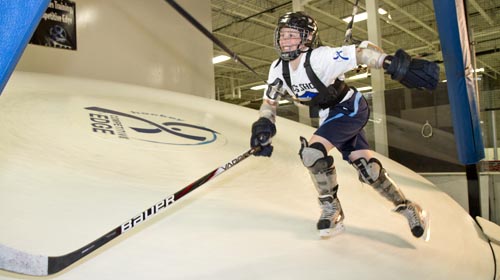Avoid the pitfalls, and it is all advantages…

A skating treadmill is a tool. Skating treadmills are not always used well. As a result, there are many very intelligent members of the Hockey community that are not fans of skating treadmills. This page is here to explain how they are misused and why they are not always supported by hockey coaches and skating coaches.
Keep in mind, we consider the “Crossover Flywheel” to be a type of skating treadmill… a “crossover skating treadmill”.
Oftentimes, the way skating treadmills are used is sort of a one-size-fits-all mode. What we mean by this is treadmills are often used primarily as ways to build strength and conditioning within stride mechanics. This is a great way to use them for a certain type of skater.
But for most youth hockey players, this just doesn’t fit. And these people who are not a fan of skating treadmills are seeing poor results from scenarios where treadmills are used as a strength and conditioning focused tool with the wrong students.
To understand why this could be, we first must understand the training concept of transferability. This concept basically compares to motor control tasks (skills) to see how similar they are. If two tasks are highly similar (say throwing a football and throwing a baseball) we can expect improvements made by working on one of these to transfer to the other. If they aren’t similar say a bench press and throwing a baseball, even though they involve a lot of the same muscles, we cannot expect much transfer from one to the other by improving one of them.
So, how similar are skating on a treadmill to skating on ice? Indeed, they are highly similar tasks, and we should expect a high degree of transfer.
But, if things are not identically the same, the high level of transfer between the two can lead to a danger. That danger is that a habit that works efficiently for one but not the other can transfer to the other if it is trained repeatedly enough. We hear about this with people who play both softball and golf where their softball swing “messes up” their golf swing. We could imagine that a baseball pitcher who over-trains as a quarterback in football would create some confusion in his pitching motion. As treadmill skating and ice-skating are very similar but not identical, this is a risk we have to account for.
So how do we do it? Here are some of the biggest issues in using skating treadmills to train for hockey skating…
- One key difference between treadmill and ice skating is the significantly increased resistance in the plastic as compared to ice.
- As players learn to skate on plastic, the main adjustment they have to make is to bring their recovery foot further forward before setting it down. Otherwise, when they set that foot down the plastic will “pull” it back, and they will fall forward.
- This issue winds up having less impact than expected because players tend to just adjust their foot position again when they return to the ice. Plus it is a matter of an inch or less difference, so it doesn’t impact on ice performance much at all.
- The next key difference is that skating treadmills can be (and usually are) tilted on an angle.
- For the Crossover Flywheel, this is a lateral tilt relative to the direction the skater is moving (a tilt from the side).
- For a skating treadmill, the tilt is from the front and creates an uphill skating situation.
- In both cases, by changing the tilt, we change the direction in which the skater pushes. On the Flywheel, more incline angle means a more lateral (as opposed to rearward) push. On the treadmill, more incline angle means a more rearward stride-push.
- With all of that said, these changes in push direction are all within the normal confines of what the game may ask a skater to do.
- When turning really sharp and hard, you will do crossovers on the ice with a very lateral push, as you would with a high inclide on the Crossover Flywheel.
- When accelerating from a stop you do push mostly to the back with your forward stride as you would with a high incline on a skating treadmill.
- The problem comes when the training gives too many repetitions at the roughly same angle (usually a high angle on a skating treadmill) and engrains that as the standard, go-to, stride.
- By constantly changing the training angle and speed, and focusing more on lower angle training on skating treadmills, you can avoid this issue and ensure players have a stride built for all game situations.
- Other considerations that can make treadmill training slightly different from skating on ice include torque, centrifugal force, wind resistance. All of these are very slightly different when considering how they impact skating in the two conditions. As such, I will not go into detail with them here, but if you are curious on how they impact skating development, feel free to reach out to andy@compedgehky.com with questions.
![]()
Some additional links that shed more light on our ability to get great results from continuous and ongoing training…<
- For a view into how our motor control system adapts to our consistent and increasing challenges, check out this page.
- What is it about the Crossover Flywheel and the Bullet Treadmill that make them especially good for creating highly adaptable and ever-increasing challenge level? Check out this page to learn the answer.